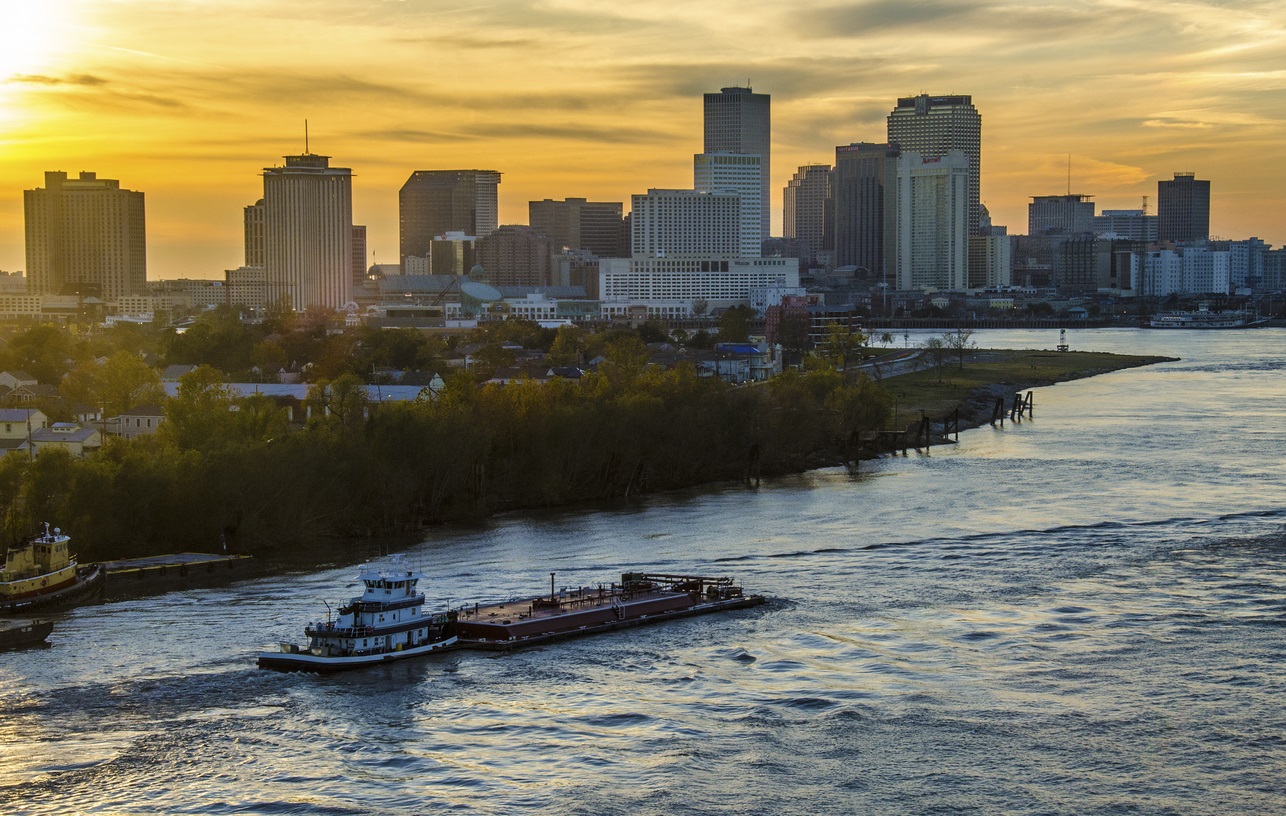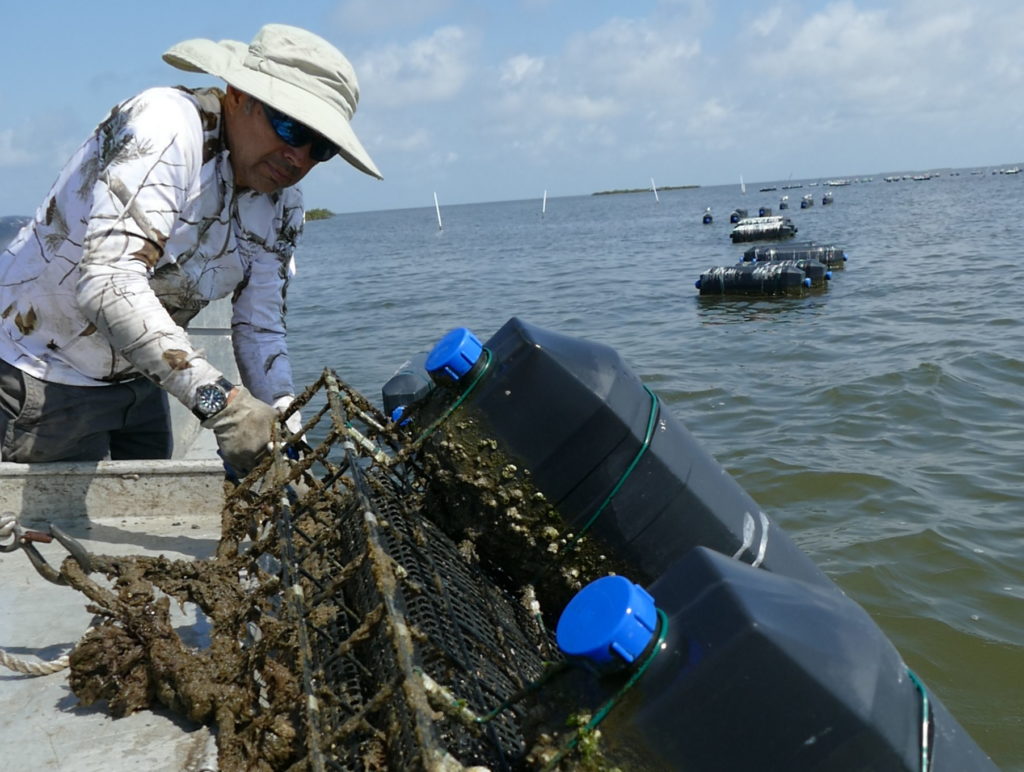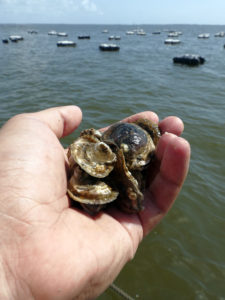
Preserving New Orleans’
“Water Economy”
Preserving New Orleans’
“Water Economy”
An annual "Water Challenge" seeks new ways to preserve the city's most vital asset.
In a shallow bay just off the Gulf of Mexico 50 miles south of New Orleans, Marcos Guerrero and his son Boris pulled a rectangular wire cage from the salty water and poured its contents into their skiff. Hundreds of quarter-sized shells tumbled out, young oysters that soon would grow into adults gracing tables in some of the city’s finest restaurants.
In three years, the Guerreros have sold 300,000 of their cultured oysters. We have been privileged to witness the success of the Guerreros through the Water Challenge, an enterprise development program the Greater New Orleans Foundation has championed in partnership with our grantee Propeller, a New Orleans nonprofit working to grow and support entrepreneurs to tackle social and environmental disparities. We conceived of this program in 2010 with the Idea Village and have funded it since then. Propeller took on the program in 2014, and in 2015, other funders started supporting the program as well.
The Water Challenge culminates in a pitched-based competition at the New Orleans Entrepreneur Week, which offers as much as $15,000 for ideas addressing the opportunities and challenges in the water sector.
Why support an oyster farm in a state whose natural reefs already supply the nation with 40 percent of its oysters?
For the same reasons we have supported enterprises providing ecotourism in swamps and marshes, protecting shorelines and levees from erosion, improving stormwater drainage, reducing landscape subsidence, rebuilding wetlands, and writing software to improve fishing efficiency.
It’s all about redirecting New Orleans’ and southeastern Louisiana’s relationship with water in the age of climate change—a relationship the state’s scientists say will determine if our region will still be above water in 50 years.
“In many important ways, the river, the wetlands and the Gulf are the economic reasons for our existence, but water has also always been a big problem,” said Ginny Hanusik, Manager of Programs at Propeller.
“Our program is designed to spark interest for innovative development of water we call the ‘water economy.’ It’s part of the movement to change the way we look at water so we see it not just as a problem, but as an opportunity.”
And that requires a cultural change for the region.

Marcos Guerrero operates an innovative oyster farm that is one of the beneficiaries of the Greater New Orleans Water Challenge. Courtesy of the Greater New Orleans Foundation.
For most of its 300 years, New Orleans and the region had a love-hate relationship with the resource that was responsible for its birth and its commercial successes. It fought to keep the Mississippi River open to commercial traffic feeding the nation’s largest port but built levees to stop its spring floods from damaging cities, farms and factories. Those same floods, however, carried the sediment that built and maintained the landscape. Once blocked from that resupply, the land began slowly sinking, but the pace increased dramatically when 10,000 miles of canals dredged for oil and gas eviscerated what was left. In only 70 years, just under 2,000 square miles of wetlands were turned to open water, removing a natural cushion to storm surge and bringing the Gulf of Mexico to the city’s back door.
When climate scientists add the region’s subsidence to the amount of human-caused sea level rise expected by the end of the century, they predict most of south Louisiana could be submerged under five feet of water by 2100 – almost twice what the rest of the Gulf and Atlantic coasts face. That would leave New Orleans on a thin ribbon of land surrounded by the open Gulf – not even a speed bump for hurricane storms surges.
Meanwhile man-made infrastructure was making matters worse. Always fearful of the flooding from the frequent sub-tropical rain storms, the city started building some of the world’s largest pumping stations to remove large amounts of rain from the city’s streets. That reduced flooding, but also began drying out the muddy sponge the city sits on. This leads to subsidence, which increases flooding during heavy rains and causes damage to streets and buildings. New Orleans has many neighborhoods with compressed soils that are subsiding at a rate of up to one-third of an inch annually, with certain areas subsiding at a rate of over an inch per year.
Most of south Louisiana could be submerged under five feet of water by 2100 - almost twice what the rest of the Gulf and Atlantic coasts face.
Neither the city nor the state paid serious attention to those problems until Hurricane Katrina led to massive flooding. The deadly storm was a catalyst for many sectors of what would become the burgeoning water economy. It prompted the state into creating its 50-year, $92 billion Coastal Master Plan aimed at rebuilding wetlands and providing storm surge barriers, but also increased public awareness to the region’s increased vulnerability to disaster caused by wetlands losses, sea level rise, and its drainage systems.
Propeller, founded in 2009 as Social Entrepreneurs of New Orleans, saw the emerging water economy as a natural fit for its mission – seeding entrepreneurship for the public good – because these businesses would be focused on what is nothing less than an existential challenge for the region. They were a natural fit for us as we worked to advanced three of our environmental priority areas: the management of urban water, the protection and restoration of the Gulf Coast, and the growth of the Southeast Louisiana water economy.
In the coming years, we see plenty of business opportunities to address these problems. The state will receive approximately $10 billion in oil spill relief, which will be used for its Coastal Master Plan, while the city and state have won over $230 million in federal grants for programs to improve the “resilience” of the city in the event of a natural disaster.

Courtesy of the Greater New Orleans Foundation
As Propeller’s Ginny Hanusik put it, “Our original thoughts were that if we could spark interest and innovation from the local talent base, we could help develop new ideas on how to treat these longstanding and serious problems outside the scope of what government is doing.”
Since we began, GNOF and Propeller have become synonymous with efforts to address those water challenges, and not just in offering help for enterprises focused on the problem. We have been active partners in providing venues for public education about the state’s coastal effort, the city’s drive to employ green infrastructure in storm water management, and the many non-profit groups that push the water agenda.
The Water Challenge continues to be one of our more successful programs in achieving that goal. We continue to invest in the Water Challenge because we’re confident in Propeller’s ability to engage our water entrepreneurs and support their solutions to our region’s water issues. The entrepreneurs are also helping to create jobs in our growing water economy.
Last year, the Guerreros’ Grand Isle Sea Farms took home the audience favorite award at the Water Challenge, not just for producing tasty oysters, but for developing a fisheries segment that could help settle a serious issue facing the state’s coastal master plan.
A major tool in the state’s plans to rebuild its sinking and eroding wetlands has been controlled sediment river diversions. Essentially floodgates built into the levees at key locations, they will be opened when the river is high, allowing its torrent of fresh water to carry sediment back into the basins to rebuild wetlands and stop subsidence in key areas of the coast. But too much fresh water will kill the oysters that have not only been a huge part of New Orleans’ world-famous cuisine, but a big industry and a key part of the water economy.
The state has plans to pay for oyster fishermen to replant oyster reef in saltier water, but that is a time consuming and expensive process.
That’s where the Guerreros’ business comes in. Their oysters are not grown on reefs attached to the water-bottom, but in cages suspended in the water column. So they can be moved anywhere there is suitable water quality.
“That could help solve the problem of diversions and oysters,” Hanusik said. “It’s a really good example of how innovation in the water economy can help us address one of our serious environmental problems.”
Ella Delio is Director of Environmental and Regional Initiatives at the Greater New Orleans Foundation. Pulitzer Prize-winning journalist Bob Marshall provided research and photography for this piece.
Philanthropy
Greater New Orleans Foundation
Project
Water Challenge


